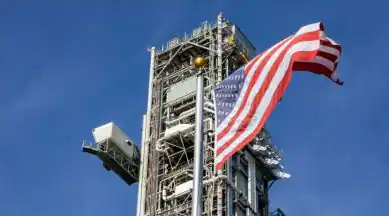
In a significant stride towards the much-anticipated Artemis program, NASA has recently accomplished a crucial milestone by transferring its mobile launcher to the launchpad. The mobile launcher, a towering structure that will facilitate the launch of the Artemis 2 crewed moon mission, has been relocated to the Kennedy Space Center’s Launch Complex 39B. This maneuver marks a pivotal step in NASA’s ambitious plans to return humans to the Moon and set the stage for future deep space exploration.
The Artemis program, named after the Greek goddess of the Moon and the twin sister of Apollo, is NASA’s initiative to land “the first woman and the next man” on the lunar surface by the mid-2020s. Artemis 2, the upcoming mission, will serve as a critical test flight of the Space Launch System (SLS) rocket and the Orion spacecraft, both of which are key components of NASA’s plan for lunar exploration.
The mobile launcher’s journey from the Vehicle Assembly Building to the launchpad was a meticulously orchestrated operation that involved a crawler-transporter, an enormous tracked vehicle that carried the structure. The intricate process required precision and coordination, with the crawler-transporter moving at an unhurried pace to ensure the safety of the mobile launcher and its associated equipment.
The mobile launcher is a towering structure standing at approximately 400 feet tall and weighs around 10 million pounds. It serves as a crucial interface between the SLS rocket, the Orion spacecraft, and the launchpad itself. The structure is equipped with various umbilicals, access arms, and environmental control systems that allow astronauts to safely board the Orion spacecraft and facilitate the connection of propellant lines and electrical connections.
The relocation of the mobile launcher to the launchpad is a significant achievement for NASA as it prepares for the Artemis 2 mission. This mission is set to carry a crew of astronauts on a journey around the Moon, marking a historic moment as humans venture beyond low Earth orbit for the first time in decades. The mission will provide vital insights into the performance of the SLS rocket and the Orion spacecraft, laying the groundwork for future crewed missions to the lunar surface and beyond.
NASA Administrator, Sarah Thomas, expressed her enthusiasm about the successful transfer of the mobile launcher, stating, “This achievement is a testament to the hard work and dedication of the entire NASA team and our partners. The Artemis program represents a new era of space exploration, and this milestone brings us one step closer to realizing our goal of sustainable lunar exploration.”
As with any complex engineering endeavor, challenges were met and overcome throughout the process. The engineering teams at NASA meticulously planned each aspect of the transfer, considering factors such as weather conditions and structural stability. The success of this operation underscores the agency’s commitment to safety and precision as it pursues its ambitious lunar exploration goals.
Looking ahead, the Artemis 2 mission will play a critical role in validating the hardware and systems required for deep space travel. The insights gained from this mission will inform subsequent missions, including Artemis 3, which aims to return humans to the lunar surface. Additionally, the Artemis program serves as a stepping stone for future missions to Mars and other destinations in the solar system.
NASA’s relocation of the mobile launcher to the launchpad for the Artemis 2 crewed moon mission test is a significant achievement that brings humanity one step closer to its lunar exploration goals. This milestone underscores NASA’s dedication to pushing the boundaries of space exploration and marks a pivotal moment in the Artemis program. As preparations for the Artemis 2 mission continue, the world watches with anticipation as NASA paves the way for a new era of space exploration and discovery.













